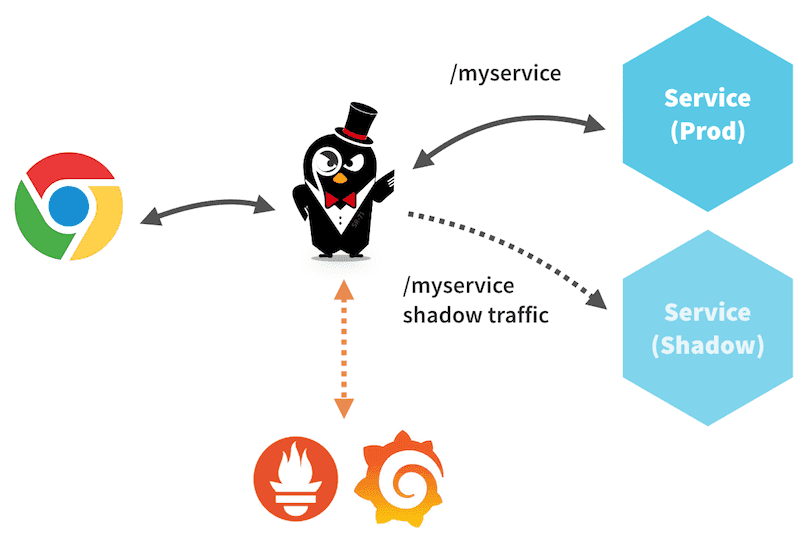DocsEdge Stack
Traffic shadowing
Traffic shadowing
Traffic shadowing is a deployment pattern where production traffic is asynchronously copied to a non-production service for testing. Shadowing is a close cousin to two other commonly known deployment patterns, canary releases and blue/green deployments. Shadowing traffic has several important benefits over blue/green and canary testing:
Zero production impact. Since traffic is duplicated, any bugs in services that are processing shadow data have no impact on production.
Test persistent services. Since there is no production impact, shadowing provides a powerful technique to test persistent services. You can configure your test service to store data in a test database, and shadow traffic to your test service for testing. Both blue/green deployments and canary deployments require more machinery for testing.
Test the actual behavior of a service. When used in conjunction with tools such as Twitter's Diffy, shadowing lets you measure the behavior of your service and compare it with an expected output. A typical canary rollout catches exceptions (e.g., HTTP 500 errors), but what happens when your service has a logic error and is not returning an exception?
Shadowing and Ambassador Edge Stack
Ambassador Edge Stack lets you easily shadow traffic to a given endpoint. In Ambassador Edge Stack, only requests are shadowed; responses from a service are dropped. All normal metrics are collected for the shadow services. This makes it easy to compare the performance of the shadow service versus the production service on the same data set. Ambassador Edge Stack also prioritizes the production path, i.e., it will return responses from the production service without waiting for any responses from the shadow service.
The shadow Mapping
In Ambassador Edge Stack, you can enable shadowing for a given mapping by setting shadow: true in your Mapping. One copy proceeds as if the shadowing Mapping was not present: the request is handed onward per the service(s) defined by the non-shadow Mappings, and the reply from whichever service is picked is handed back to the client.
The second copy is handed to the service defined by the Mapping with shadow set. Any reply from this service is ignored, rather than being handed back to the client. Only a single shadow per resource can be specified (i.e., you can't shadow the same resource to more than 1 additional destination). In this situation, Ambassador Edge Stack will indicate an error in the diagnostic service, and only one shadow will be used. If you need to implement this type of use case, you should shadow traffic to a multicast proxy (or equivalent).
You can shadow multiple different services.
During shadowing, the host header is modified such that -shadow is appended.
Example
The following example may help illustrate how shadowing can be used. This first attribute sets up a basic mapping between the myservice Kubernetes service and the /myservice/ prefix, as expected.
What if we want to shadow the traffic to myservice, and send that exact same traffic to myservice-shadow? We can create a new mapping that does this:
The prefix is set to be the same as the first mapping, which tells Ambassador Edge Stack which production traffic to shadow. The destination service, where the shadow traffic is routed, is a different Kubernetes service, myservice-shadow. Finally, the shadow: true attribute actually enables shadowing.
Shadow traffic weighting
It is possible to shadow a portion of the traffic by specifying the weight in the mapping. For example:
In the example above, only 10% of the traffic will be forwarded to the shadowing service.







